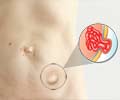Incisional Hernias - Symptoms
The two most common symptoms of Incisional hernias are discomfort and a bulge. The bulge of an incisional hernia is located in the incision itself.
Typically, there are no symptoms on awakening but with prolonged periods of standing, sitting, or lifting the symptoms appear and often intensify.
Incisional hernias are usually associated with:
- A burning sensation,
- A pressure or fullness
- An ache or constant pain at the site of the hernia
- An awareness that something is present in the incision that should not be there
Reducible hernia- The bulge may be always present but typically goes away when the patient lies down. The reason is that the pressure that pushes tissue into the hernia when the patients stand is eliminated when the patient lies down because the tissue goes back into the abdomen. People can often push in the bulge (reduce the hernia), by applying gentle, steady pressure over the lump.
Incarcerated hernia- If the lump does not go away, the tissue is stuck. This is known as an incarcerated hernia and is almost always associated with unrelenting discomfort. This requires early surgical attention.
Bowel Obstruction- An incarcerated hernia can lead to bowel obstruction, which causes pain, abdominal distention and vomiting. This is a surgical emergency and if left alone can put the life of the patient at risk.
Strangulated hernia- If the neck of the hernia is narrow - there is always the risk of strangulation of the hernia. In this situation the blood supply to the intestine or the structure in the hernial sac is cut off and this leads to gangrene. This can be catastrophic and fatal if not treated immediately by surgery.














